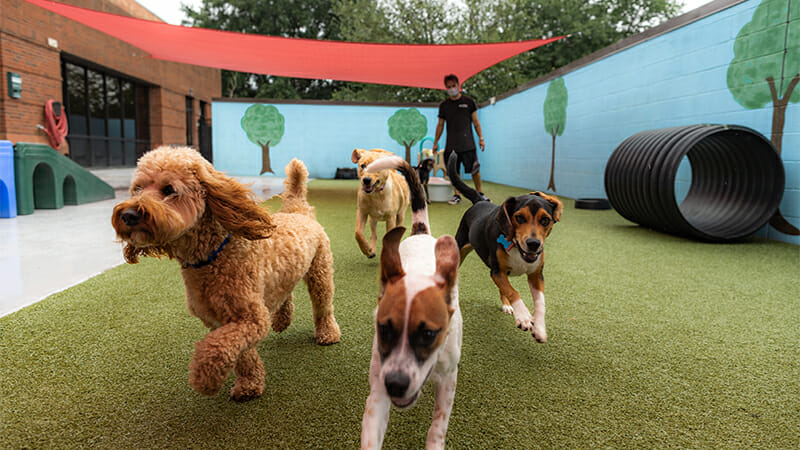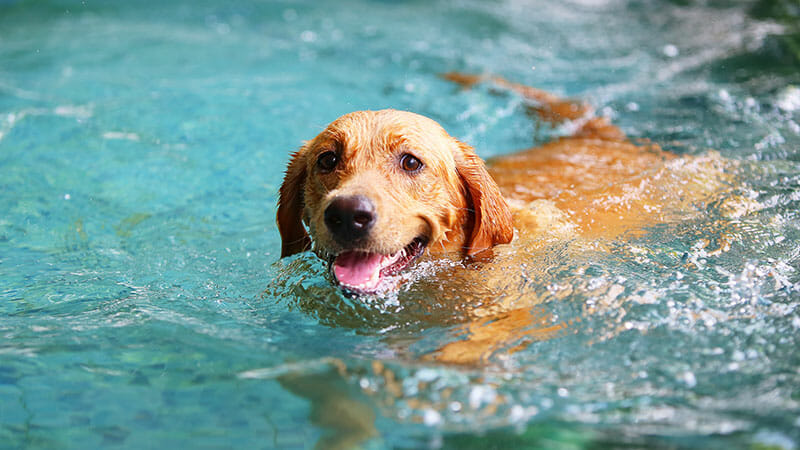If you’re concerned your dog isn’t getting enough exercise, look out for the tell-tale signs:
- Destructive behavior
- Rough play
- Weight gain
- Restlessness
- Excessive barking
- Sluggishness or depression
- Pulling at the leash
- Pestering or annoying behavior
Notice your dog doing one or more of these behaviors? Not enough exercise could be the cause. Keep reading for tips and suggestions for getting your dog just the right amount of exercise they need.
Puppies
For example, healthy puppies of all breeds tend to have more energy than adult dogs—but they get all their exercise in short bursts. Think zoomies! That means shorter walks and play sessions multiple times a day will be better for your growing pup. If you want more guidance, talk to your vet about how much daily exercise is appropriate.
Adults
Adult dogs’ exercise requirements are largely determined by their breed. Your border collie is going to need a lot more exercise than your neighbor’s bulldog, for example. One might be game to train for a marathon with you, but the other might chase a ball a couple of times and call it a day.
It’s also important to keep your dog’s health in mind. If they have a medical issue—such as hip dysplasia or heart and respiratory problems—it will limit the amount and type of exercise they can do. For example, dogs with hip dysplasia and other musculoskeletal issues might find swimming enjoyable because of its low impact on the joints, while a dog with heart or respiratory problems will likely be happier taking a calm stroll with you.
Seniors
Proper exercise is just as important for senior dogs as it is for puppies. As dogs reach their advanced years and start to slow down, keeping them active will help to prolong their life by keeping them mobile and reducing the risk of obesity. You know your dog best, so watch for signs that they’re slowing down—you might need to adjust how much and the type of exercise they’re getting every day to make them more comfortable.
Outdoor Exercises
1. Hiking
Dogs love being outside, so the next time you go hiking, bring your dog along! Make sure to pack extra water and a portable dog bowl.
2. Swimming
Some dogs aren’t fans of water, but those who are get to experience one of our favorite forms of exercise: swimming! It’s great for dogs with joint problems because of its low impact on the joints. Give your dog a life jacket to keep them safer and help them stay in the water longer.
3. Fetch
A favorite pastime of many dogs, fetch is a great way to exercise your dog. Switch it up and keep it interesting by changing locations and toys regularly.
4. Draft Work
Large breeds were originally bred to work, so many dogs are likely to enjoy pulling a sled or a cart. If you’ve been wanting to try something new with your dog who likes to pull and has endless stamina, draft work could be the perfect solution.
5. Obedience
Obedience work is great for dogs who take things a little slower. Practicing recall, retrieving, and reinforcing basic commands stimulates them mentally, as well as physically. If you want to keep it interesting, teach them some fun new tricks, like weaving or rolling over.
6. Dog Sports
If you’re not already familiar with the dog-sports scene, you might be surprised to learn just how many activities you can choose from. To name a few, there’s:
- Lure coursing
- Scent work
- Agility
- Obedience
- Flyball
- Dock diving
- Schutzhund
- Rally
See one that piques your interest? Go with your dog and give it a try! Start by looking for local clubs in your area, then attend a meetup to see if it’s something you think you and your dog would enjoy.
7. Dog Park or Doggy Daycare
If you’re away from home for a chunk of the day, it might be hard to schedule time for exercise. That’s where doggy daycare comes in! Drop your dog, and they’ll be supervised all day while they romp and play with their pals.
Indoor Exercises
1. Stairs
If the weather is bad or you can’t make it outside, running up and down the stairs is a great alternative. Just remember that it’s as hard for your dog as it is for you—and pay special attention to dogs with long backs and short legs, such as dachshunds and corgis.
2. Hide-and-Seek
Playing a game of hide-and-seek with your dog provides not only exercise, but also mental stimulation. You can also work in a game of chase when they find you!
3. Treadmill
Have a treadmill? Your high-energy dog might love a treadmill workout. Just make sure to get them used to the treadmill and train them to use it correctly.
4. Tug
Games of tug, when played properly, build muscle and the human-animal bond. Most dogs enjoy tug, and there are a wide variety of tug toys available.
5. Agility
When we think of agility, we usually think of outdoor courses or large indoor agility spaces. However, you can make your own agility course with household supplies, such as broom handles, boxes, Hula-Hoops, and ottomans. Practice your agility skills at home, or consider joining a local club with an indoor agility space.
Start an Exercise Routine Today!
Now that you have a better idea of how much exercise your dog needs and the plethora of options available to you, start a new exercise routine with your dog, and consider using doggy daycare if you’re crunched for time. We always enjoy adding a new member to the Lucky Dog family!




